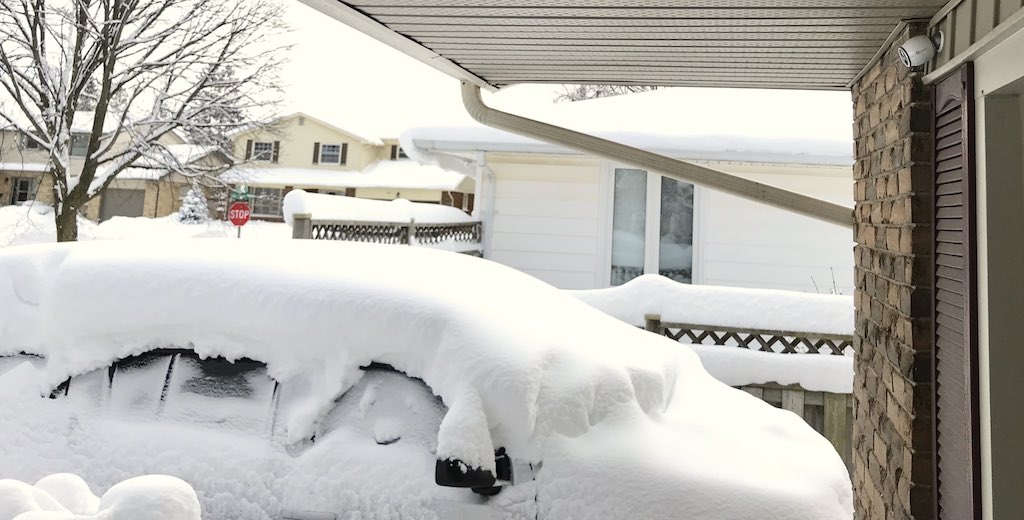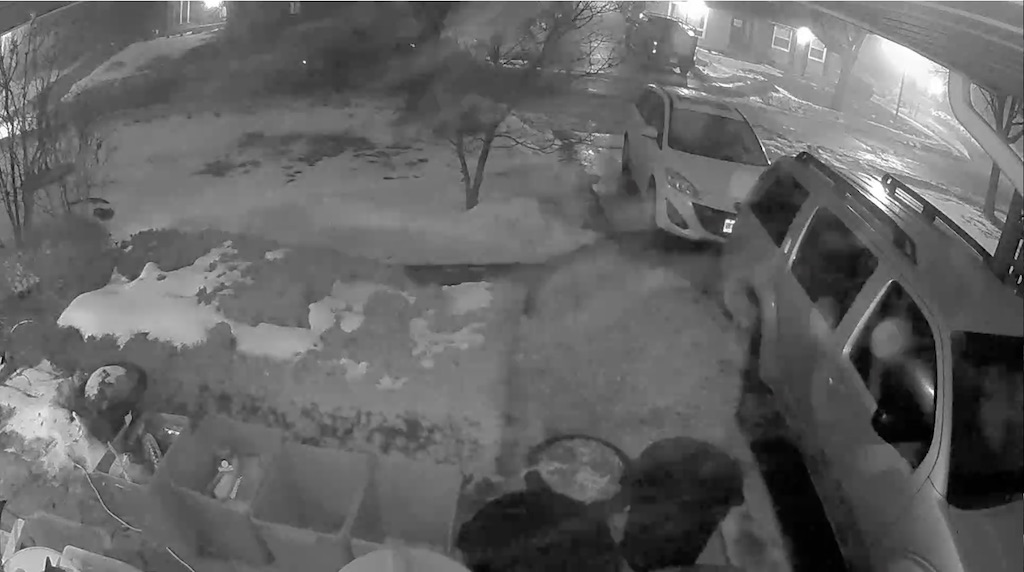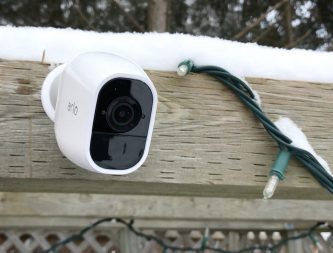
Over the past several months, I’ve had the opportunity to try out a collection of outdoor security cameras. Models I’ve tested include popular models like Netgear’s Arlo 2, and the EZVIZ Mini Trooper.
During the course of my evaluations of these cameras, I’ve run into a few issues, including some environmental issues that will affect many Canadians. I made notes, took pictures and put together a post listing some considerations you might want to take into account if you’re considering installing new outdoor security cameras for your home.
Battery Life in extreme cold conditions
Canadian winters are rough on batteries. At least winters where I live, in Southwestern Ontario. I’m told they aren’t quite so bad in parts of British Columbia ….
 The problem with cold is that the chemical reactions that power batteries slow as the temperature drops. At -20 degrees Celsius, most batteries drop to 50% efficiency and as it gets colder, the impact is worse. You can see the effect in this chart that Energizer published to show the effect of cold on one of its Lithium-ion batteries.
The problem with cold is that the chemical reactions that power batteries slow as the temperature drops. At -20 degrees Celsius, most batteries drop to 50% efficiency and as it gets colder, the impact is worse. You can see the effect in this chart that Energizer published to show the effect of cold on one of its Lithium-ion batteries.
That’s why your smartphone sometimes shuts down moments after you start using it outdoors on a cold day. I have a smart door lock, and while my door is insulated, the lock mechanism itself is exposed directly to the elements—and it connects to the battery case. In extreme cold, even though the batteries are actually positioned inside the house, that exposure to cold can drop the battery life for the door lock from a few months to less than a week.
 I quickly noticed the same problem with the battery powered wireless security cameras. The EZVIZ Mini Trooper was showing more than 50% battery life one day. The next day, we hit around -30 degrees Celsius and the camera immediately dropped to red and began throwing low battery warnings. The one that I’ve had the best luck with is the Arlo 2 camera. I don’t know if that’s because it uses a rechargeable pack instead of replaceable batteries, or maybe the large size, but it’s done the best job in cold weather, going weeks at a time even in extreme cold temperatures. And then it’s just two hours on the charger and they’re back in business, so it’s a minor inconvenience.
I quickly noticed the same problem with the battery powered wireless security cameras. The EZVIZ Mini Trooper was showing more than 50% battery life one day. The next day, we hit around -30 degrees Celsius and the camera immediately dropped to red and began throwing low battery warnings. The one that I’ve had the best luck with is the Arlo 2 camera. I don’t know if that’s because it uses a rechargeable pack instead of replaceable batteries, or maybe the large size, but it’s done the best job in cold weather, going weeks at a time even in extreme cold temperatures. And then it’s just two hours on the charger and they’re back in business, so it’s a minor inconvenience.
Remember to fully charge the camera batteries before leaving for an extended period in the winter, though, or you risk the cameras going dark when you’re on vacation.
Effect of cold on Wi-Fi Range
Battery powered, wireless security cameras are one of the greatest developments in home security. They’re great. But in the rush to position cameras in places around your property that offer excellent viewing angles, don’t forget about Wi-Fi range. These cameras use a base station, and it’s not usually as powerful as recent generations of Wi-Fi routers—with their big amplifiers and powered external antennas. So even if your smartphone gets a decent Wi-Fi signal in the depths of your yard, that doesn’t necessarily mean your wireless security camera will too.
Keep Wi-Fi range in mind when planning the placement of your cameras and that base station.
It’s also worth noting that precipitation has the potential to degrade Wi-Fi signals. Rain, snow, and fog all result in air filled with water droplets, and water is one of the materials that can be trouble for Wi-Fi. It would have to be pouring heavily to have a serious impact on a solid Wi-Fi signal, but if you position an outdoor camera far enough away, then a wall of precipitation between your home and the camera could be enough to make the connection spotty.
Snow poses a particular problem for security cameras
Snow isn’t just a pain to shovel, it can mess with outdoor security cameras in multiple ways.

Blowing snow obscures your view when you log onto your security camera to have a look. Some cameras—especially if motion sensitivity is set to high levels—can trigger an alert because of blowing snow. I’ve had chunks of snow sliding off my roof trigger motion alerts. And then there’s the problem of snow accumulation. It can pile up and obscure what was once a clear view. Blowing and drifting snow can also collect in partially sheltered areas and actually bury or coat the lens of an outdoor security camera. If you’re in Canada (at least most parts of Canada), you might want to keep snowfall in mind when you position your cameras.
Adjust brightness controls on security cameras
When you think of a security camera, you probably aren’t thinking about the ability to fine-tune the image quality. I’m not talking about flipping to a lower resolution to save battery, I mean adjusting image quality settings like brightness and contrast. Believe it or not, this is a really useful feature.
I’ve run into many situations where the video and photos from an outdoor camera have details completely blown out because the image is washed out by glare. Snow is a big culprit for this kind of problem, but sunny days with no snow on the ground can be just as bad. It’s asking a bit much for a consumer-level security camera to automatically adjust its image capture to compensate, but some—like the Arlo Pro 2—do let you manually adjust the setting yourself. And it can make a huge difference.
Effect of wind on security cameras
I’ve yet to run into winds that were blustery enough to actually budge an outdoor camera that was held in place by a magnetic mount. That’s a testament to just how well these mounts work. I love them, because a magnetic mount combined with a wireless, battery-powered camera means you can stick a security camera literally anywhere you want coverage.
 However, I have run into issues where wind gusts were strong enough to set off the sound detection sensors on microphone-equipped security cameras. If you run into phantom sound-triggered alarms on a windy day, turning down the sensitivity of the microphone so it’s not triggered by howling wind may do the trick.
However, I have run into issues where wind gusts were strong enough to set off the sound detection sensors on microphone-equipped security cameras. If you run into phantom sound-triggered alarms on a windy day, turning down the sensitivity of the microphone so it’s not triggered by howling wind may do the trick.
Have you run into any other issues that someone looking at an outdoor security camera might want to take into account? If so, please feel free to share in the comments.
Best Buy has all the latest in home security solutions for Canada (even the cold parts of Canada) including cameras, smart locks, and alarms.




Thank-you for providing a reality-check on battery life in cold weather.
I notice the stand-by power of my car battery has similar challenges. I need to run outside with a battery charger with an older battery in cold weather.
Comments are closed.